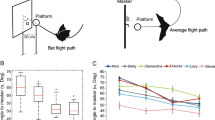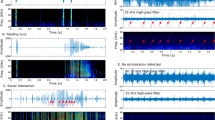Abstract
Bats that capture animal prey from substrates often emit characteristic echolocation calls that are short-duration, frequency-modulated (FM) and broadband1. Such calls seem to be suited to locating prey in uncluttered habitats, including flying prey, but may be less effective for finding prey among cluttered backgrounds because echoes reflecting from the substrate mask the acoustic signature of prey2,3,4. Perhaps these call designs serve primarily for spatial orientation5,6,7. Furthermore, it has been unclear whether the acoustic image conveyed by FM echoes enables fine texture discrimination3,8,9, or whether gleaning bats that forage in echo-cluttering environments must locate prey by using other cues, such as prey-generated sounds5,6,7,10,11,12,13. Here we show that two species of insectivorous gleaning bats perform badly when compelled to detect silent and immobile prey in clutter, but are very efficient at capturing noisy prey items among highly cluttered backgrounds, and both dead or live prey in uncluttered habitats. These findings suggest that the short, broadband FM echolocation calls associated with gleaning bats are not adapted to detecting prey in clutter.
This is a preview of subscription content, access via your institution
Access options
Subscribe to this journal
Receive 51 print issues and online access
$199.00 per year
only $3.90 per issue
Buy this article
- Purchase on Springer Link
- Instant access to full article PDF
Prices may be subject to local taxes which are calculated during checkout


Similar content being viewed by others
References
Neuweiler, G. Foraging ecology and audition in echolocating bats. Trends Ecol. Evol. 4, 160–166 (1989).
Simmons, J. A., Kick, S. A., Moffat, A. J. M., Masters, W. M. & Kon, D. Clutter interference along the target range axis in the echolocating bat, Eptesicus fuscus. J. Acoust. Soc. Am. 84, 551–559 (1988).
Neuweiler, G. Auditory adaptations for prey capture in echolocating bats. Physiol. Rev. 70, 615–640 (1990).
Schnitzler, H. U. & Kalko, E. K. V. Echolocation by insect-eating bats. Bioscience 51, 567–569 (2001).
Fuzessery, Z. M., Buttenhof, P., Andrews, B. & Kennedy, J. M. Passive sound localization of prey by the pallid bat (Antrozous p. pallidus). J. Comp. Physiol. A 171, 767–777 (1993).
Bell, G. P. Behavioral and ecological aspects of gleaning by a desert insectivorous bat, Antrozous pallidus (Chiroptera: Vespertilionidae). Behav. Ecol. Sociobiol. 10, 217–223 (1982).
Faure, P. A. & Barclay, R. M. R. The sensory basis of prey detection by the long-eared bat, Myotis evotis, and the consequences for prey selection. Anim. Behav. 44, 31–39 (1992).
Simmons, J. A. & Stein, R. A. Acoustic imaging in bat sonar: echolocation signals and the evolution of echolocation. J. Comp. Physiol. A 135, 61–84 (1980).
Schmidt, S. Evidence for a spectral basis of texture perception in bat sonar. Nature 331, 617–619 (1988).
Faure, P. A., Fullard, J. H. & Barclay, R. M. R. The response of tympanate moths to the echolocation calls of a substrate gleaning bat, Myotis evotis. J. Comp. Physiol. A 166, 843–849 (1990).
Anderson, E. & Racey, P. A. Feeding behavior of captive brown long-eared bats Plecotus auritus. Anim. Behav. 42, 489–493 (1991).
Anderson, E. & Racey, P. A. Discrimination between fluttering and non-fluttering moths by brown long-eared bats, Plecotus auritus. Anim. Behav. 46, 1151–1155 (1993).
Barclay, R. M. R. & Brigham, R. M. Constraints on optimal foraging: a field test of prey discrimination by echolocating insectivorous bats. Anim. Behav. 48, 1013–1021 (1994).
Faure, P. A. & Barclay, R. M. R. Substrate-gleaning versus aerial-hawking: plasticity in the foraging and echolocation behaviour of the long-eared bat, Myotis evotis. J. Comp. Physiol. A 174, 651–660 (1994).
Arlettaz, R. Feeding behaviour and foraging strategy of free-living mouse-eared bats Myotis myotis and Myotis blythii. Anim. Behav. 51, 1–11 (1996).
Johnston, D. S. & Fenton, M. B. Individual and population-level variability in diets of pallid bats (Antrozous pallidus). J. Mammal. 82, 362–373 (2001).
Schumm, A., Krull, D. & Neuweiler, G. Echolocation in the notch-eared bat, Myotis emarginatus. Behav. Ecol. Sociobiol. 28, 255–261 (1991).
Schmidt, S., Hanke, S. & Pillat, J. The role of echolocation in the hunting of terrestrial prey—new evidence for an underestimated strategy in the gleaning bat Megaderma lyra. J. Comp. Physiol. A 186, 975–988 (2000).
Siemers, B. & Schnitzler, H. U. Natterer's bat (Myotis nattereri, Kuhl, 1818) hawks for prey close to vegetation using echolocation signals of very broad bandwidth. Behav. Ecol. Sociobiol. 47, 400–412 (2000).
Jensen, M. E., Miller, L. A. & Rydell, J. Detection of prey in a cluttered environment by the northern bat Eptesicus nilssonii. J. Exp. Biol. 204, 199–208 (2001).
Arlettaz, R., Perrin, N. & Hausser, J. Trophic resource partitioning and competition between the two sibling bat species Myotis myotis and Myotis blythii. J. Anim. Ecol. 66, 897–911 (1997).
Arlettaz, R. Habitat selection as a major resource partitioning mechanism between the two sympatric sibling bat species Myotis myotis and Myotis blythii. J. Anim. Ecol. 68, 460–471 (1999).
Norman, A., Jones, G. & Arlettaz, R. Noctuid moths show neural and behavioural responses to sounds made by some bat-marking rings. Anim. Behav. 57, 829–835 (1999).
Habersetzer, J. & Vogler, B. Discrimination of surface-structured targets by the echolocating bat Myotis myotis during flight. J. Comp. Physiol. A 152, 275–282 (1983).
Weibel, E. R., Taylor, C. R. & Bolis, L. Principles of Animal Design: The Optimization and Symmorphosis Debate (Cambridge Univ. Press, Cambridge, 1998).
Brigham, R. M. & Barclay, R. M. R. Prey detection by common nighthawks: does vision impose a constraint? Ecoscience 2, 276–279 (1994).
Acknowledgements
We thank L. Delaloye, S. Parsons and K. Zbinden for assistance. R.A. was supported by a postdoctoral fellowship from the Swiss National Science Foundation, a research grant from the Association for the Study of Animal Behaviour, and a grant from the Vaud Academic Society. G.J. was funded by a Royal Society University Research Fellowship. We thank M. B. Fenton and J. Rydell for comments.
Author information
Authors and Affiliations
Corresponding author
Rights and permissions
About this article
Cite this article
Arlettaz, R., Jones, G. & Racey, P. Effect of acoustic clutter on prey detection by bats. Nature 414, 742–745 (2001). https://doi.org/10.1038/414742a
Received:
Accepted:
Issue Date:
DOI: https://doi.org/10.1038/414742a
This article is cited by
-
Effect of environmental gradients on community structuring of aerial insectivorous bats in a continuous forest in Central Amazon
Mammalian Biology (2023)
-
Acoustic differentiation and its relationships with ear size in three Histiotus species (Chiroptera, Vespertilionidae) from Patagonia, Argentina
Mammal Research (2023)
-
Mid-flight prey switching in the fringed-lipped bat (Trachops cirrhosus)
The Science of Nature (2022)
Comments
By submitting a comment you agree to abide by our Terms and Community Guidelines. If you find something abusive or that does not comply with our terms or guidelines please flag it as inappropriate.



